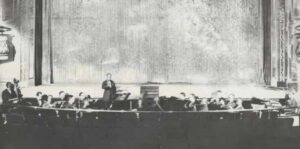YOUR DAILY DOSE OF EUBIE!!!
Once Shuffle Along was cast, coproducer John Cort agreed to provide the company with a place to stage the show–albeit one of the least-desirable theaters that he owned. Located a half-mile from the northernmost point of Times Square, Daly’s 63rd Street Music Hall stood on the corner of Broadway. It was hardly a well-known space; a critic for the New York Age described it as being “sandwiched between garages and other establishments representative of the automobile industry, [which] was little known to the average Broadway theatregoer.” The space had a small stage and hardly a backstage at all. It didn’t even have an orchestra pit, so the first three rows were removed and the boxes demolished to accommodate the musicians. Being used primarily as a lecture hall, there was very little depth to the stage. Even though the stage was extended a few feet, most of the dance numbers were limited to being choreographed horizontally across the width of the stage. A makeshift curtain was added and soon the space was a passable theatre. Blake commented that the theatre, “violated every city ordinance in the book,” adding ironically, “It wasn’t Broadway but we made it Broadway.”

Previously a lecture hall, the theater reopened in November 1919 as a recital hall for classical soloists. According to the New-York Tribune, “The name was selected…despite the fact that the term ‘music hall’ has become more or less identified with vaudeville in America.” The owners, instead, sought to draw on the English concept of a hall for “legitimate” concerns and recitals. Germaine Schnitzler, a classical pianist, gave the opening concert, and the remodeled theater had a seating capacity of 1062 and 12 boxes seating an addition 84 patrons. The paper praised the halls acoustics, saying it compared music could be “more perfectly enjoyed than in…the great spaces of Carnegie or … the smaller reaches of the Aeolian.”

In April 1920, the theater had its first association with African-Americans when a film on the subject of William Hayward’s “famous colored regiment” was shown, in a special screening attended by Governor Al Smith. By then, the theater was mostly showing movies, with a mix of political events. A “Grand Protestant Rally” led to a riot between its members and a rival Catholic group, resulting with the police responding to break up the brawl. In short, this was hardly a theater with an illustrious history presenting Broadway musicals—nonetheless, within a few months of Shuffle Along’s opening, 63rd Street had to be changed to a one-way to accommodate the large crowds coming to see the show. The area would be a victim of urban renewal in the 1950s when the new Lincoln Center was planned and built.